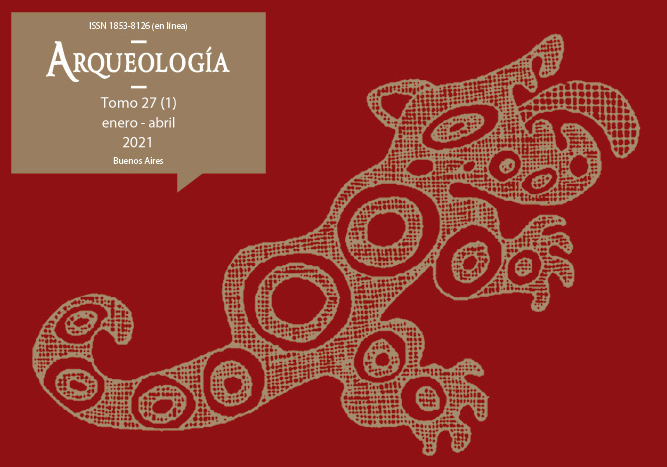Introducción de ganado europeo en la Puna jujeña y su rol en las economías tradicionales. Zooarqueología del sitio histórico Antigal Laguna
Downloads
References
Adams, B. y Crabtree, P. (2012). Comparative Osteology. A Laboratory and Field Guide of Common North American Animals. Nueva York: Academic Press.
Angiorama, C., Becerra, M. F. y Pérez Pieroni, M. J. (2015). El mineral de Pan de Azúcar. Arqueología histórica de un centro minero colonial en la Puna de Jujuy (Argentina). Chungara, Revista de Antropología Chilena, 47(4), 603-619. http://dx.doi.org/10.4067/S0717-73562015005000045
Aramendi, B. (2016). El distrito de la Puna y su primer subdelegado. Intendencia de Salta del Tucumán, 1784-1795. Fronteras de La Historia, 22(1), 12-37.
Barrientos, G., Goñi, R., Zangrando, A., Del Papa, M., García Guraieb, S., Arregui, M. J. y Negro, C. (2007). Human taphonomy in Southern Patagonia: a view from the Salitroso Lake Basin (Santa Cruz, Argentina). Taphonomy and Zooarchaeology in Argentina, 1601(1426), 187-201.
Behrensmeyer, A. K. (1978). Taphonomic and ecologic information from bone weathering. Paleobiology, 4(2), 150-162.
Binford, L. R. (1981). Bones. Ancient Men and Modern Myths. Orlando: Academic Press.
Capparelli, A., Lema, V., Giovannetti, M. y Raffino, R. (2005). The introduction of Old World crops (wheat, barley and peach) in Andean Argentina during the 16th century AD: archaeobotanical and ethnohistorical evidence. Vegetation History and Archaeobotany, 14(4), 472-484. DOI: 10.1007/s00334-005-0093-8.
Cornaglia Fernandez, J. (2012). El carbonato de calcio y sus implicancias en el análisis de los conjuntos arquefaunísticos. El caso de Laguna El Doce (Departamento General Lopez, Provincia de Santa Fe). Revista del Museo de Antropologia, 5(1), 185-194. DOI: 10.31048/1852.4826.v5.n1.9138.
Crosby, A. W. (1986). Ecological Imperialism. The Biological Expansion of Europe, 900 - 1900. Nueva York: Cambridge University Press.
Gil Montero, R. (2009). Mountain pastoralism in the Andes during colonial times. Nomadic Peoples, 13(2), 36-50. DOI: 10.3167/np.2009-1302203.
Hongo, H. (1998). Patterns of animal husbandry in central Anatolia in the second and first millenia BC: Faunal remains from Kaman-kalehöyük, Turkey. En H. Buitenhuis, L. Bartosiewicz y A. M. Choyke (Eds.), Achaeozoology of the Near East III. Procedings of the Third International Symposium on the Archaeological of Southwestern Asia and Adjacent Areas (pp. 255-275). Groningen: ARC (Publicatie 18).
Hopkins, C. E., Hamm, T. E. y Leppart, G. L. (1970). Atlas of Goat anatomy. Part I: Osteology. Maryland: Edgewood Arsenal Department of the Army.
Lyman, R. L. (1994). Vertebrate Taphonomy. Cambridge: Cambridge University Press.
Madero, C. M. (2000). Modelo etnoarqueológico de estructura etaria en contextos pastoriles actuales de la Puna de Jujuy. Cuadernos del Instituto Nacional de Antropología y Pensamiento Latinoamericano, 19, 285-399.
Mengoni Goñalons, G. L. (1980). Notas zooarqueológicas I: Fractura en huesos. En Actas del VII Congreso Nacional de Arqueología (pp. 87-91). Montevideo: Centro de Estudios de Arqueología.
Mengoni Goñalons, G. L. (1999). Cazadores de Guanacos de la Estepa Patagónica. Buenos Aires: Sociedad Argentina de Antropología.
Nielsen, A. E., Angiorama, C., Maryñanski, J., Avila, F. y López, M. L. (2015). Paisajes prehispánicos tardíos en San Juan Mayo (Frontera Argentina-Bolivia). Arqueología, 21, 33–65.
Otero, C. y Rivolta, M. C. (2015). Nuevas interpretaciones para la secuencia de ocupación de Tilcara (Quebrada de Humahuaca, Jujuy). Intersecciones en Antropologia, 16(1), 145-159.
Pacheco Torres, V. R., Altamiro, A. J. y Guerra Porras, E. S. (1986). The Osteology of South American Camelids. Los Angeles: Institute of Archaeology, University of California.
Palomeque, S. (2000). El mundo indígena (siglos XVI-XVII). Historia Colonial, 2, 87-145.
Quiroga, L. (2015). Del páramo a la Puna. Textos y contextos arqueológicos para una descripción del paisaje altoandino en la gobernación del Tucumán. Corpus. Archivos Virtuales de la Alteridad Americana, 5(2). DOI: 10.4000/corpusarchivos.1516.
Sanhueza, M. C. (1992). Tráfico caravanero y arriería colonial en el siglo XVI. Estudios Atacameños, 10, 169-182.
Vaquer, J. M. (2016). La ocupación colonial temprana (S . XVI y XVII) en Casas Quemadas (Cusi Cusi , Rinconada , Jujuy): primeras aproximaciones a las relaciones entre lo global y lo local. Revista de Arqueología Histórica Argentina y Latinoamericana, 10(2), 1-26.
Von Rosen, E. (1957). Restos de una cultura indígena. En Un Mundo que se Va (pp. 87-125). San Miguel de Tucumán: Instituto Miguel Lillo, Universidad Nacional de Tucumán.
Wheeler, J. C. (1982). Aging llamas and alpacas by their teeth. Llama World, 1(2), 12-17.
Yacobaccio, H. D. (2007). Andean camelid herding in the South Andes: Ethnoarchaeological models for archaeozoological research. Anthropozoologica, 42(2), 143-154.
Yacobaccio, H. D. (2014). Arqueología ambiental, arte rupestre y gestión del patrimonio cultural en Barrancas (Abdón Castro Tolay, Puna de Jujuy). Informe a la Comisión Municipal de Barrancas. Manuscrito inédito.
Copyright (c) 2021 Julia Merler Carbajo

This work is licensed under a Creative Commons Attribution-NonCommercial-ShareAlike 4.0 International License.
Authors who publish in this journal agree to the following conditions:
- Authors retain copyright and yield to the journal right of first publication with the work registered with attribution license Creative Commons, which allows third parties to use the published always mentioning the authorship of the work and first publication in this magazine.
- Authors can make other independent and additional contractual arrangements for the non-exclusive distribution of the version of the article published in this issue (p. Eg., Inclusion in an institutional repository or publish it in a book), provided that clearly indicate that the work was published for the first time in this magazine.
- It allows and encourages the author / s to publish their work online (eg institutional or personal pages) before and during the process of revision and publication, as it can lead to productive exchanges and greater and more rapid dissemination of work published (See The Effect of Open Access).





(1)13.png)






1.jpg)
1.jpg)


13.png)
1.png)


(1)1.png)









